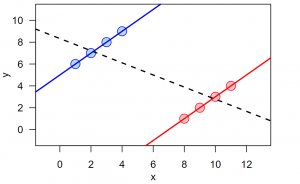Simpson’s Paradox and Safety Analytics
We previously wrote about Goodhart’s law and how it poses a challenge to analytics over a period of time in the sense that “when a measure becomes a target, it ceases to be a good measure.” But that is not the only quirky phenomenon named after a researcher that can get in the way of reliable analytics.
Simpson’s paradox is the notion that an effect or relationship that appears within groups vanishes or even reverses when those groups are combined. This can be a trap for those who casually and naively approach data analytics.
As an example, one of our safety analytics clients was interested in learning whether so-called “safety observations” were having an impact on reportable injury rates. This was not a “big data” exercise; data was available in small spreadsheets and dashboards. General corporate managers could see what they believed was a substantial impact of safety observations when looking at all operating regions as a whole. Therefore they advocated for increased safety observations.

What to do about this? First, data literacy is important. That is recognizing that phenomenon like this exist. Then, taking additional time for high- and low-level data analysis. Second, understanding that confounding factors (other correlated variables) may be obscuring true relationships. And finally, valuing the usefulness of formal statistical modeling as a remedy. This is because statistical models, if appropriately structured, can account for grouping phenomenon. They can also incorporate confounding factors.
We have seen this in applications beyond safety, most recently, in our work modeling the pandemic.
Safety analytics is a powerful tool to help keep people safe. But as is often the case in all kinds of data analysis, simple summaries and cursory reviews have pitfalls.